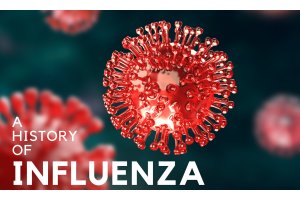Flu Season...Where are you?
As COVID-19 presses forward, it is easy to look back at the past year and see nothing but the ruin left behind by the pandemic.
However, as 2021 advances, there appears to be a light at the end of the tunnel. Unlike previous years, the 2020-2021 flu season has diminished immensely. Healthcare workers are reporting extraordinarily low levels of Influenza-Like-Illness (ILI) and it may be due to several precautions taken during the pandemic.(1)
In the early part of 2020, many restrictions were instated in the United States and around the world to prevent spread of viral particles. Travel became more restrictive; lockdowns occurred in certain countries; many businesses were forced to close or move to remote operation; masks became mandatory; and social distancing was enforced. For many, these restrictions were not met with open arms and they came at a great sacrifice. Now that flu season should be in full swing, we are seeing some positive side effects to the pandemic we had not fully anticipated: a drastic decrease in ILI.
It is estimated that a typical flu season in the U.S. results in anywhere from 9-45 million illnesses, from 140,000-180,000 hospitalizations, and from 12,000-61,000 deaths. For this year's season, the CDC is currently reporting that of 886,237 collected samples, only 1,553 have tested positive (0.2%) for flu. (2) A typical flu year, as seen in 2019-2020, typically contains a 27.7% positive ILI sample rate. (3) To further emphasize the quell in flu cases, the CDC reports that national percentage of visits to health centers for ILI is at 1.08%, which is much lower than last year's 6.7%. (4)
Another factor to consider when looking at the depression in ILI rates for the 2020-2021 flu season is vaccination rates. In 2020, the CDC reported a record 175 million flu vaccination doses were distributed, and projected that for 2021 the U.S. could provide up to about 195 million doses. (5) As of January 15th, 2021, there have been 193 million doses distributed with several months before flu season officially ends. (6)
Why is there more than a 100-fold decrease in flu infections this season?

Although healthcare workers may enjoy seeing a decrease in ILI, the implications have some epidemiologists worried. Richard Webby, a virologist at St. Jude’s Hospital in Tennessee, warns that the reduction in influenza outbreaks for the 2020-2021 flu season may reduce circulation of several less common but less severe strains, which could limit viral competition and potentially allow for new, more aggressive swine flu variants to thrive. He states, "One of the things holding those viruses back a lot is natural immunity. If flu is low for a few seasons, that might leave a gap for swine viruses to have more impact.”(7)
There is no question that 2020 hit the world hard, but with it came some enduring lessons in preventive measures to limit viral outbreaks. The combination of quarantine, masks, social distancing, and vaccination have shown a notable increase in empty hospital beds for our more common winter nemesis, and resulted in a 100-fold reduction in positive ILI samples. The lack of flu this season does have some worried, but it is a pleasant sign to see a reduction in at least one viral illness after the havoc from the pandemic.
Oddly enough, in spite of the flu decrease, the rhinovirus, which is responsible for the common cold, has had some sharp increases this season. One reason may be that, unlike the coronaviruses, the rhinovirus lacks an outer lipid coat, which makes the coronavirus vulnerable to soaps and sanitizers.
Hopefully, we have all learned a valuable lesson from this experience. If many of the safety precautions can continue to be upheld to some degree for future flu seasons, perhaps the trend will continue downward.
By Miles Amby
R&D Microbiologist II
References
- https://clpmag.com/disease-states/infectious-diseases/covid-19/the-pandemic-broke-the-flu/
- https://www.cdc.gov/flu/weekly/index.htm#ILIActivityMap
- https://www.statista.com/chart/20704/us-flu-seasons-percent-of-samples-tested-positive/
- https://gis.cdc.gov/grasp/fluview/fluportaldashboard.html
- https://www.cdc.gov/flu/fluvaxview/coverage-1920estimates.htm
- https://www.cdc.gov/flu/fluvaxview/dashboard/vaccination-dashboard.html
- https://www.nature.com/articles/d41586-020-03519-3







